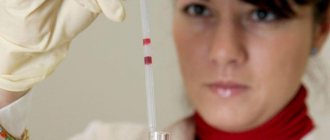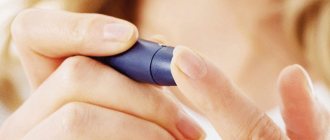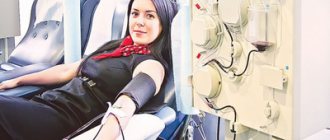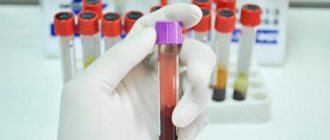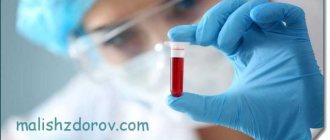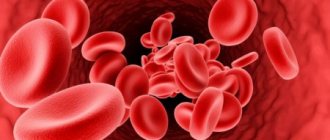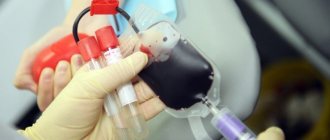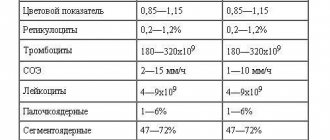Taking blood and determining indicators is a diagnostic procedure that can provide expanded information about your health status. Based on the data obtained from the analysis, it is possible to make a preliminary diagnosis, clarify in which area to look for the problem, and prescribe additional instrumental examinations. During therapy, using blood sampling from a vein, the dosage and frequency of administration of pharmacological drugs are adjusted, and it is determined whether the patient requires additional consultations.
Description of the blood collection procedure
To take blood from a vein, the patient's forearm is lightly tightened with a tourniquet. The patient is asked to clench and unclench his fist to increase blood flow. The skin in the elbow area is wiped with an alcohol wipe, after which a hollow needle is inserted into the vein. Through this needle, blood is drawn from a vein and the required number of tubes is filled.
After this, the needle is pulled out, and a sterile cotton swab is applied to the insertion site and secured to the arm with a bandage. After taking blood from a vein, you need to walk with such a bandage for no more than 5-7 minutes.
To determine different blood parameters, various methods, various reagents and equipment are used. Therefore, be prepared to fill several tubes depending on the required number of indicators.
Why do they take blood from a vein?
In recent years, modern laboratories have used only venous blood for research. Previously, capillary blood from the ring finger was used for some tests, for example, in the case of a general blood test. With this method of collecting biomaterial, microthrombi often formed, which made it difficult to calculate the studied parameters.
Venous blood collection using vacuum systems
Taking blood from a vein provides comprehensive information about the state of health and allows you to prescribe the necessary instrumental examination methods to clarify the diagnosis. The most frequently used clinical methods are those that reveal the nature of the pathological process, allow the treatment of the disease to be adjusted, and are also used for screening and preventive examinations.
- A general blood test reveals the cellular composition of the blood and ESR. Prescribed for the diagnosis of inflammatory diseases, infections, blood pathologies. Refers to a mandatory examination method during annual medical examinations.
- Blood biochemistry determines the main biological indicators (glucose, proteins, electrolytes, enzymes, lipids) and indicates the pathology of the liver, heart, blood vessels, and the development of oncology.
- Hormonal background studies the level of hormones and the function of the endocrine, digestive system, and metabolism.
- The immunological status determines the state of cellular and humoral immunity, the development of allergic reactions.
Donating blood from a vein is required when diagnosing any disease. Laboratory tests are safe and painless methods for identifying pathological processes in the body.
Basic blood test indicators
Hemoglobin is a protein found in red blood cells. Its main function is to provide the body with oxygen. Both increased and decreased hemoglobin levels may indicate serious disorders: problems with the gastrointestinal tract, iron deficiency anemia, heart failure, etc.
Erythrocytes are red blood cells. Their excess can lead to thickening of the blood and the appearance of frequent headaches, dizziness, and nosebleeds. A low red blood cell count often leads to fatigue and tinnitus.
Reticulocytes are the precursors of red blood cells that are formed in the bone marrow. If their content is reduced, this may indicate a disruption in the formation of red blood cells. An increased content of reticulocytes may indicate the presence of blood loss.
Platelets are blood platelets responsible for blood clotting. A deviation of the platelet level from the norm may indicate the presence of serious diseases, such as tuberculosis, cancer of the liver and kidneys, bone marrow lesions, and leukemia.
ESR is the erythrocyte sedimentation rate. It may indirectly indicate the presence of an inflammatory process in the body.
Leukocytes are white blood cells. Their deficiency may indicate, among other things, the presence of an infectious disease.
Neutrophils are one of the types of leukocytes. Help the body fight bacteria. Their reduced content may indicate the presence of a severe infection in the body. If other blood parameters are normal, an increase in the level of neutrophils does not indicate the presence of serious problems in the body.
Lymphocytes are cells of the immune system. An increase in the level of white blood cells can be observed in children during the period of recovery from infectious diseases. A decrease in the content of lymphocytes in the blood is observed at the onset of the disease.
Monocytes are a type of white blood cell. Their function is to cleanse the body and support the immune system. An increase in their content may indicate an inflammatory or oncological disease.
Eosinophils are white blood cells responsible for destroying foreign protein in the body. They are elevated in allergic diseases.
Basophils are white blood cells, an increase in the content of which may indicate the presence of an inflammatory process or a foreign body in the body, as well as inflammation in the digestive organs and disruption of the thyroid gland.
Plasmocytes are cells that are part of the immune system and are responsible for the production of immunoglobulins (antibodies). They may appear in the blood during infectious diseases such as chickenpox, rubella, and measles.
How to prepare for the procedure?
The blood collection algorithm requires special preparation for the event. The reliability of the analysis results is influenced by the following factors:
- time of collection of biological fluid;
- food intake, the nature of foods in the diet;
- drinking alcoholic beverages, smoking;
- taking medications;
- physiotherapy;
- intense physical activity;
- stressful situations;
- instrumental diagnostic methods (MRI, ultrasound, x-ray);
- cyclical changes in a woman’s body (mensis).
Before taking blood from a vein, you should adhere to general rules that will increase the efficiency of the study and minimize the risk of obtaining false results.
- Blood is donated on an empty stomach in the morning (8.00 – 11.00). You can drink water without carbon dioxide.
- On the eve of the examination, it is not recommended to overeat, eat salty, spicy, or fatty foods.
- The day before the test, avoid drinking alcohol.
- It is necessary to submit biomaterial before undergoing instrumental examination and physiotherapeutic treatment.
- Coordinate the discontinuation of medications with your doctor.
- One hour before the examination, you should not smoke; it is necessary to exclude stressful situations and physical overexertion.
Repeated blood tests to monitor indicators over time should be carried out under the same conditions (time, diet) and in the same laboratory, since the blood sampling algorithm, study methods and reference values (norms) may differ significantly in different medical institutions.
After the procedure
Although blood donation is safe in most cases, it takes away blood components and iron from the body, which take time to replenish the body. After donating blood, a person can take care of himself:
- Adopting a healthy diet
: Anyone who donates blood should consume healthy foods to replace lost iron. - Treating bruises
: Some people may experience bruising around the injection site. If this happens, you will need to place an ice pack on the area. The next day, you can apply a warm compress to the area. - Time between blood donations
: A minimum of 56 days must pass between donations. A person can donate whole blood and platelets, or undergo up to six platelet donations, over an 8-week period.
Many blood centers allow blood donations every 4, 8, or 16 weeks, depending on the type of donation.
Preparing for the study
Almost all the data that is determined after taking blood from a vein is reliable only “on an empty stomach.” Therefore, the optimal time for manipulation is morning. The preparation rules, regardless of the purpose of the research, are the same:
- The day before the procedure, do not drink alcohol and adhere to healthy eating rules.
- You need to stop taking medications for 1-2 days. If this cannot be done, be sure to tell the doctor who evaluates the results what was treated, the doctor,
- A day before the manipulations, you should not go to the bathhouse or sauna; it is advisable to limit physical activity.
- When testing blood sugar, you should not use sweet toothpaste or chewing gum.
Before entering the office, you need to calm down, restore your breathing, and sit for at least 15 minutes. Overexcitement, stress, fatigue are the reasons to get unreliable indicators.
What tests require venous blood?
Upon admission to the hospital for the main indicators indicating the need for hospitalization, a biological sample is taken from the finger.
Using the express test, in 7-12 minutes you can obtain data - the level of hemoglobin, leukocytes and erythrocyte sedimentation rate - ESR. And to make or clarify the diagnosis, blood sampling from the elbow bend is widely practiced. Based on the results of the analyses, it is possible to determine:
- ratio of formed units of physiological fluid - to assess the probable inflammatory process, regardless of etiology, pathological changes in the blood;
- biochemical indicators - the level of AlAtov, AsAtov, cholesterol, lipids, enzymes, electrolytes - the data is sufficient to assess the functions of various organic systems;
- hormonal background - it is used to judge the functioning of the digestive, endocrine and reproductive systems, as well as the speed of metabolic processes;
- immunological status - including the likelihood of developing allergic reactions;
- possible allergens;
- the presence of a pathogenic pathogen and an antibiotic to which it is not resistant.
Tumor markers are identified from venous blood - proteins that are released into the blood during malignancy of tumors. Thanks to the analysis, it is possible to make a diagnosis and begin treatment at an early stage.
Attention!
A general analysis is performed not only when a disease is suspected or hospitalized, but also at every preventive examination. It is used to determine whether further treatment is needed.
Rules for blood sampling
The reliability of the result depends on the technique of taking biomaterial.
Incorrect vein puncture, changes in procedures, or compromised sterility may lead to misdiagnosis or serious complications for the patient. Despite the fact that the diagnostic procedure is not considered a “serious” study, it can provoke the development of complications. When a vessel is punctured, a hematoma is formed; failure to comply with antiseptic measures leads to phlebitis. In case of secondary infection - an unsterile needle or insufficient treatment of the puncture site, sepsis is possible.
Attention! More often, the culprits of adverse consequences are the patients themselves, who remove the anesthetic tampon from the wound early, or introduce pathogenic microorganisms with dirty hands.
Increased temperature, swelling and inflammation of the skin around the puncture are a sign of infection. In this case, to stop the development of sepsis, you need to consult a doctor.
Syringe collection algorithm
The packaging of the disposable syringe is opened directly in front of the patient. Based on the instructions, the tube is labeled. Some laboratories ask for personal information. Nurse actions:
- the patient is asked to take a comfortable position - often sitting, but sometimes, if there is a tendency to dizziness, lying down;
- the hand should be placed on the table or next to you, a cushion should be placed under the elbow;
- a tourniquet is tightened on the forearm and you are asked to work with your fist to enhance the filling of blood vessels;
- the site of the future puncture is disinfected, often with an alcohol-containing liquid;
- when piercing, the needle is turned with the cut down;
- use a piston to draw out the required amount of blood;
- the biological sample is poured into a test tube, and the syringe is sent into a disinfectant solution for subsequent disposal.
A cotton swab soaked in a disinfectant solution is applied to the puncture site; it is recommended to press it as tightly as possible. If the fence was made from the elbow, it is better to bend the arm. After the procedure, it is advisable not to leave the medical facility until the bleeding stops. In some patients, blood clotting may be impaired due to stress factors.

